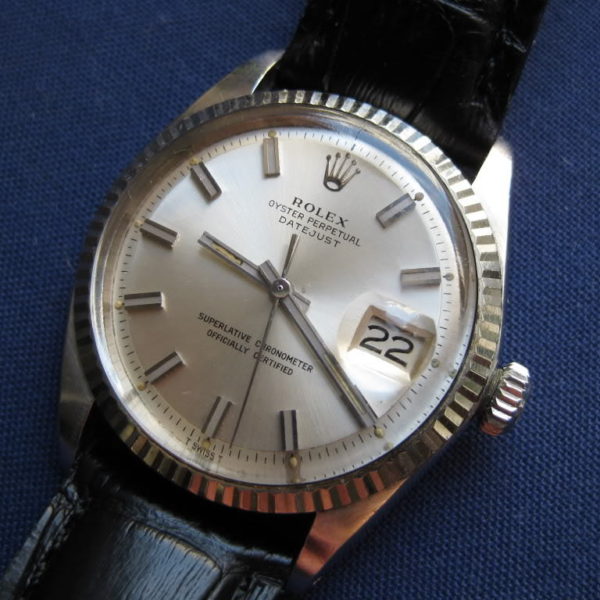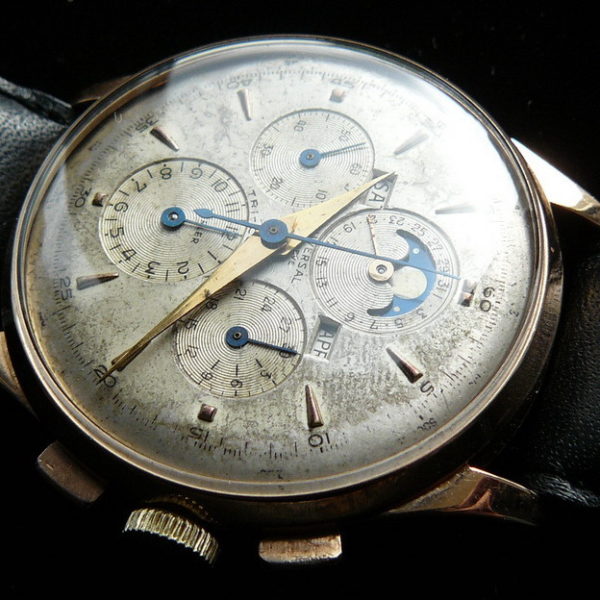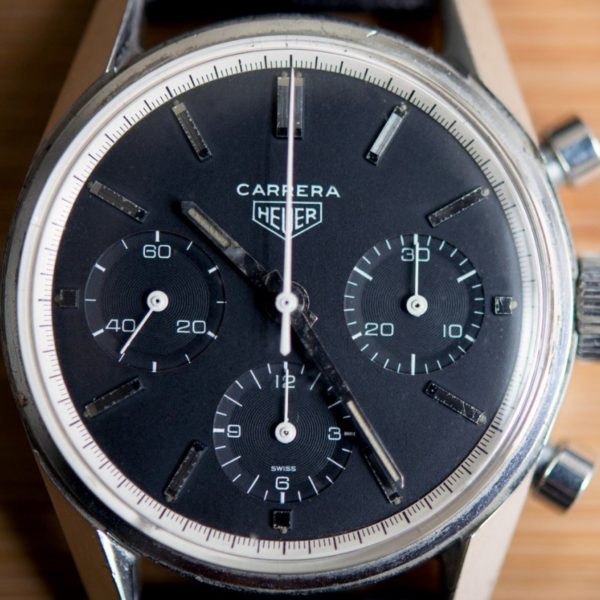
- Stephen Pulvirent, Associate Editor of Bloomberg Media
- Rolex Datejust
- Universal Geneve TriCompax
- Heuer Carrera
- Longines Calatrava in stainless steel
Wearing a vintage watch can be a nice way to sport something with a little history, but unless you’re a seasoned watch enthusiast, buy something second hand can be intimidating. Prices are often high and the true condition of any piece is often somewhat murky. If you’re able to score something nice, however, you have the pleasure of wearing something distinctive for the rest of your life.
I recently spoke to my friend Stephen Pulvirent about his thoughts on vintage watches. Stephen used to be the associate editor of Hodinkee, but now works as the associate editor of Bloomberg Pursuits, where he specializes in watches, design, and technology. If anyone knows about watches, it’s him.
Vintage watches seem particularly popular right now. Is that a recent thing, or has that always been the case? What makes vintage timepieces so appealing?
Vintage watches have been growing in popularity over the last few decades, but the last 5-10 years has seen them explode. Blogs and social media have played a huge role in this, letting young guys and new collectors see a lot more watches than they could have before – as with many things, vintage watches are all about exposure. The more you see, the more you learn, the better position you’re in to buy. I’m young (25) and I think for guys my age there’s something fun about having an analog device on your wrist. Everything else in my world is digital, so why not have something a little different.
Vintage watches sometimes feel like they’re as much about stories as they are timepieces. What are some of the cooler stories you’ve heard personally?
Vintage watches are all about stories and these stories can be mundane or they can be fantastical. I have a Rolex GMT from 1970 and because I have the paperwork, I know exactly what store in Switzerland sold it and on what day it went home with its first owner. I have no idea who it was, but even that little bit adds so much meaning to the watch.
A common story is “this belonged to my father or grandfather,” but that’s still the most meaningful for most people. I have a little gold Longines dress watch that belonged to my great grandfather. It’s arguably the least impressive watch in my collection and the one I would part with last, no question.
Then there’s the other extreme. At the Beyer watch store in Zurich they have a museum in the basement. In a nondescript glass case is a little Rolex that is the actual watch that went up Everest with Edmund Hilary in 1953. The actual watch. Looking at it through the glass gave me chills.
Benjamin Clymer over at Hodinkee once said that any time you buy a vintage watch, you’re “at war” with the seller. It’s a battle over who knows more about the particular desirability of a watch, its overall condition, and who can play the game better. When buying something, how do you ensure that you’re not getting something that’s going to break down in a year, or something that’s a “Frankenwatch?” How do you determine fair market value?
Instead of thinking about being “at war” with the seller, I prefer to think that you’re buying the seller as much as the product. I only buy from people I trust. Sure, they need to make a little money off me, and I have no problem with that, but I want to know in exchange that if something goes wrong I have someone to turn to. If I ever get the feeling someone’s trying to cheat me, that’s it, we don’t do business.
If you’re buying on eBay (a great way to find watches if you’re willing to put in the research and take the risk), you don’t really have any assurance except for someone’s word. So, you have to be prepared for possible breakdowns. You’re purchasing (in many cases) a 50 year old mechanical object that’s traveled multiple laps around the globe. Stuff goes wrong, and if you’re not OK dealing with that, vintage watches probably aren’t for you. I once bought a pretty no-frills watch on eBay and spent the next six months sending it back and forth with watchmakers. Was it annoying? Sure. But I knew it was a possibility and was happy once the watch was on my wrist.
“Frankenwatches” are a danger, especially if you don’t do your due diligence. If you find something that looks awesome, try to find another or at least a picture of another. Compare, ask some friends or jump on a forum, and read all the blogs. The chances that you find something truly unique are low, so comparisons are the best way to validate something.
Also, this is an opinion unpopular with most watch collectors and professionals, but I believe it very strongly. If you’re just buying a watch to wear that you enjoy the look of, and don’t mind viewing it as a flat-out purchase and not an investment, don’t worry too much about Frankenwatches, refinished dials, and the like. Yes, watches like this are not collectable at all, and no, you won’t be able to resell them down the line, but if one comes at a good price and it makes you happy, go for it. These are watches we’re talking about. If they’re not fun, it’s all a farce.
Where are some of the best places to buy a vintage watch? Do you think it’s better to go with dealers or auctions houses? How do you feel about eBay?
Auction houses are great places to find mid-level and higher-level pieces, but on the entry level they’re usually not the best way to go. Dealers are there snatching those watches up and you’re likely to get a better price and bigger selection elsewhere. The 20% buyer’s premium will kill you on this stuff.
Ebay is a good choice, but you need to be very careful and know what you’re doing. For every incredible watch on eBay there are 100 flat-out fakes. Buying from a professional with a reputation to protect is always recommended. It’s not in their best interest to screw you, so you can know you’re safe. The last thing a vintage dealer wants is a flurry of comments flying around the internet saying they’re a cheat.
Four favorite vintage watches?
Wow, this is tough. Really tough, actually. I think I’ll do some of my all-time favorites that I think are good for everyone – from beginners to more advanced collectors. The sort of watches that a seasoned collector will nod at when they see it on your wrist, but that anyone can appreciate.
- Rolex Datejust: It might seem like a boring choice, but a vintage Datejust (which can run anywhere from $2,200 up to $3,500 or more depending on the dial color, condition, etc.) is one of the greatest watches ever made. It’s a tank and you can wear it with literally everything from a t-shirt to a tux. If you’re only going to own one watch, you can’t do much better than this.
- Universal Geneve TriCompax: The brand is now defunct, but Universal Geneve truly made incredible watches and they can be had for relatively reasonable prices. A TriCompax combines a chronograph, a moonphase, and a triple calendar in one watch and can still be had for well under $10k (sometimes even under $5k if you really look). They’re some of the best watches out there for the money, though they’ve gotten much more expensive in the last two or three years.
- Early Heuer Carrera: There’s no doubt that the Rolex Daytona is the king of vintage chronographs. It just is. But with prices starting well over $20k for even the most basic vintage Daytona, the Carrera looks more and more appealing. You can get an incredible early example for a little under or over $5,000 and own a real piece of watch history with enough money left over for a car.
- Longines Calatrava in stainless steel: If you want a time-only steel watch from the ‘40s or ’50s and don’t want to pay $100,000+ for it, Longines is the way to go. The calatrava-style watches come in dozens of styles, which does mean you need to do some homework to make sure you end up with something genuine, but they’re awesome looking watches containing great movements and will run you $2,000-4,000 on average.












